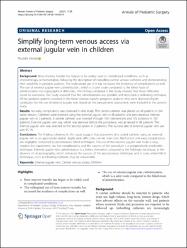| dc.contributor.author | Akman, Mustafa | |
| dc.date.accessioned | 2021-05-27T08:29:03Z | |
| dc.date.available | 2021-05-27T08:29:03Z | |
| dc.date.issued | 2021 | en_US |
| dc.identifier.citation | Akman, M. (2021). Simplify long-term venous access via external jugular vein in children. Annals of Pediatric Surgery, 17(1).
https://dx.doi.org/10.1186/s43159-021-00085-9 | en_US |
| dc.identifier.issn | 1687-4137 | |
| dc.identifier.issn | 2090-5394 | |
| dc.identifier.uri | https://dx.doi.org/10.1186/s43159-021-00085-9 | |
| dc.identifier.uri | https://hdl.handle.net/20.500.12511/6947 | |
| dc.description.abstract | Background: Bone marrow transfer has begun to be widely used in complicated conditions, such as chemotherapy or hemodialysis, following the description of indwelling central venous catheters and demonstrating their suitability in pediatric patients. The widespread use of it has increased the incidence of complications as well. The use of external jugular vein catheterization, which is a safer route compared to the blind route of administration, has topographical difficulties. The findings obtained in this study showed that these difficulties could be overcome. Our study revealed that the catheterization was possible and described a facilitating technique. Of the pediatric patients involved in the bone marrow transfer programs, patients who were deemed eligible candidates for the use of external jugular vein, based on the preoperative assessment, were included in the present study. Results: No early complication was observed in this study. The central catheter was placed on all patients in the same session. Catheters were inserted using the external jugular vein in 98 patients and percutaneous internal jugular vein in 2 patients. A central catheter was inserted through 105 interventions and 103 incisions in 100 patients. External jugular vein use, which was planned before the procedure, was achieved in 98 patients. The internal jugular vein was selected as the second option in 2 patients. The success rate of external jugular vein use was 95.1%. Conclusions: The findings obtained in this study suggest that placement of a central catheter using an external jugular vein is an appropriate option. Application difficulties can be overcome. Mechanical and early complications are negligible compared to percutaneous blind techniques. The use of the external jugular vein route is easy, requires less equipment, has few complications, and the success of the procedure is a preoperatively predictable technique. External jugular vein catheterization is a better alternative compared to the Seldinger technique, in the absence of ultrasonography, which enhances the success of the percutaneous technique, and in cases where blind techniques, such as bleeding diathesis, may be unfavorable. | en_US |
| dc.language.iso | eng | en_US |
| dc.publisher | Springer | en_US |
| dc.rights | info:eu-repo/semantics/openAccess | en_US |
| dc.rights | Attribution 4.0 International | * |
| dc.rights.uri | https://creativecommons.org/licenses/by/4.0/ | * |
| dc.subject | External Jugular Vein | en_US |
| dc.subject | Central Venous Access | en_US |
| dc.subject | Children | en_US |
| dc.title | Simplify long-term venous access via external jugular vein in children | en_US |
| dc.type | article | en_US |
| dc.relation.ispartof | Annals of Pediatric Surgery | en_US |
| dc.department | İstanbul Medipol Üniversitesi, Tıp Fakültesi, Cerrahi Tıp Bilimleri Bölümü, Çocuk Cerrahisi Ana Bilim Dalı | en_US |
| dc.authorid | 0000-0002-6789-4585 | en_US |
| dc.identifier.volume | 17 | en_US |
| dc.identifier.issue | 1 | en_US |
| dc.relation.publicationcategory | Makale - Uluslararası Hakemli Dergi - Kurum Öğretim Elemanı | en_US |
| dc.identifier.doi | 10.1186/s43159-021-00085-9 | en_US |
| dc.identifier.scopusquality | Q4 | en_US |



















